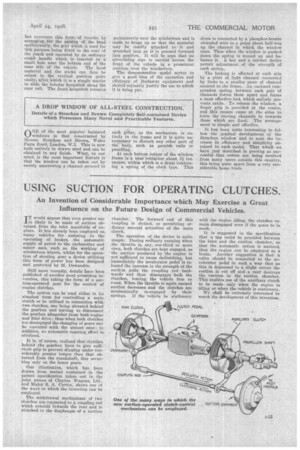USING SUCTION FOR OPERATING CLUTCHES.
Page 69

If you've noticed an error in this article please click here to report it so we can fix it.
An Invention of Considerable Importance which May Exercise a Great Influence on the Future Design of Commercial Vehicles.
IT would appear that even greater use is likely to be made of Ruction obtained from the inlet manifolds of engines. It has already been employed on.. many vehicles for assisting in the operating of brakes, the automatic supply of petrol to the carburetter and minor uses, such as the working of windscreen wipers, whilst for the operation of steering gear a device utilizing this form of power has been designed and protected by M. Dewandre.
Still more recently, details have been Published of another most promising invention, this taking the form of a suction-operated gear for the control of engine clutches.
The system can be used either in its simplest form for controlling a main clutch or be utilized in connection With two clutches, one being situated behind. the gearbox and serving to disconnect the gearbox altogether from both engine and filial drive; thus when both clutches are disengaged the changing of gears can be executed with the utmost ease ; in addition, an automatic coasting. effect is obtained.
It is, of course, realized that clutches behind the gearbox have to give sufficient grip to prevent slipping under considerably greater torque than that obtained from the crankshaft, this occur"ring only on the lower gears.
Our illustration, which has been drawn from matter contained in the
• patent specification taken out in the joint names of Clayton Wagons, Ltd., and Major S. A. Currin, shows one of the ways in -which the invention can be employed.
The withdrawal mechanisms of two clutches are connected to a coupling rod which extends' towards the rear and is attached to the diaphragm of a suction chamber. The forward end of this coupling is slotted, so permitting ordinary manual actuation of the main clutch.
The operation of the device is quite simple. During ordinary running when the throttle is, say, one-third or more open, both clutches are kept engaged, as the suction produced by the engine is not sufficient to cause declutching, but immediately the accelerator pedal is released the increase in the strength of the suction pulls the coupling rod backwards and thus disengages both the clutches, leaving the vehicle free to coast. When the throttle is again opened suction decreases and the clutches are automatically re-engaged by their springs. If the vehicle be stationary with the engine idling, the clutches remain disengaged even if the gears be in mesh.
It is suggested in the sitecification that a tap could be provided between the inlet and the suction chamber, so that the automatic action is assisted, thus the engine .can be entployed as a brake. Another suggestion is that a valve should be connected to the accelerator pedal in such a way that as this is depressed to a slight extent the suction is cut off and a vent destroys the vacuum inthe suction chamber. This enables use of the auxiliary clutch to be made only when the engine is idling or when the vehicle is stationary.
We shall be extremely interested to watch the development of this invention.




















































































































